I take Memorial Day seriously. Every June 6, you can find me at Seoul National Cemetery showing respect to those who fought and died for Korean independence (and other prominent persons). This year was different since I would be traveling 139 kilometers south to Daejeon—the site of Korea’s other national cemetery. More than twice as big as the original and just as carefully manicured, it opened in 1985. Of the cemetery’s 110,000 graves, I was intent on visiting that of Hong Beom-do.
Born in 1868 in Jaseong County, up near the border with China, he made a living as a hunter. Accustomed to holding and using guns, Hong was furious when the Japanese demanded that the populace disarm. This was in 1907, before Japan had officially annexed Korea. He responded by forming the Righteous Army of Jeongmi which carried out hit-and-run attacks against Japanese garrisons. The “tiger of Mount Baekdu” operated in Manchuria, training larger groups of Koreans who would cross the Tumen River to smite the colonizers whenever possible. Hong’s men fought all along the border—in Manchuria and in Pyongan, Chagang, Hamgyeong and Hwanghae provinces.
Combining his troops with those of Ahn-mu and Choi Jin-dong, Hong was now head of the Korean Northern Army Command. Emboldened by the March 1, 1919 independence movement, he engaged the Japanese at the Battle of Samdunja and achieved victory. It was but a prelude to the Battle of Bongo-dong (also known as the Battle of Fengwudong) in which Hong’s 1,300 men inflicted a bitter defeat on a Japanese battalion, killing 125 and wounding 300. The significance of these two admittedly small-scale military encounters is that the Koreans would not capitulate. They were going to resist and do all they could to restore their country’s sovereignty.
Despite these and other heroics, Hong was buffeted by bigger military and political forces. Japan started a scorched-earth policy in Manchuria which forced him and the men in his charge to seek refuge in the Russian Far East, the site of considerable anti-Korean and anti-Chinese sentiment. That led to him joining the Red Army, one requirement being that a soldier declare his allegiance to the tenets of Communism. Hong was among 171,000 Koreans forcibly relocated by order of Joseph Stalin to Kazakhstan in 1937. The long-time freedom fighter did menial jobs in the city of Kyzylorda before dying there six years later. He missed out on seeing the Japanese defeat at the end of World War II as well as the division of Korea around the 38th parallel.
Not forgotten, Hong was posthumously awarded the Order of Merit for National Foundation in 1963, and a stamp was issued in 2018 commemorating the 150th anniversary of his death and another in 2020 which marked the 100th anniversary of the Battle of Bongo-dong. In 2021, almost 80 years after his death, and following lengthy negotiations between Korea and Kazakhstan, Hong’s remains were returned to the land for which he had fought and suffered. A special military aircraft (escorted by six fighter jets once it reached Korean airspace) brought him home. A solemn ceremony took place at Seoul Air Base in Seongnam, Gyeonggi Province and then another when his Taekgukki-draped coffin was lowered into the ground at Daejeon National Cemetery.
I just had to see Hong’s grave on this warm Memorial Day. A subway ride was followed by a bus ride, which was followed by getting directions from a young woman inside Daejeon Station, which was followed by a taxi ride, which was followed by a subway ride, which was followed by a shuttle bus ride in which the man in the seat next to me used the Papago translation app on his hand phone to tap out a message: “Why are you here? Why are you doing this?” He was perplexed to see a foreigner visiting Daejeon National Cemetery. I explained simply that I am an amateur historian, that I have been here a long time and that I identify as an American-Korean.
I spent 13,000 won on a bouquet of white flowers and strolled through the main gate. Thirty minutes later, I came to a section of graves that were a step above those for the row upon row of deceased soldiers from Korean War times, but certainly did not rival that for Sohn Kee-chung (gold medal winner of the 1936 Olympic marathon), Lee Jong-wook (director-general of the World Health Organization) or Hwang Jang-yop (the highest-ranking politician to defect from North Korea) or other such notable burials.
Shortly after I laid my flowers on Hong’s headstone, I met a black-clad man named Jeong Yong-chan (“Simon”). He was there with a female friend. Simon, who spoke good English, informed me that he works as an information security expert. We took copious photos and talked, mostly about the illustrious General Hong. Simon was able to allay my main concern about him—that he may have been a Communist. He did join the Red Army, after all. And he did attend the 3rd World Congress of the Communist International (“Comintern”) in Moscow in the summer of 1921 and listen to a fiery speech from Lenin. No, said my friend, he did not support the Bolsheviks. That was an expedient move, as the Russians were against the Japanese. “My enemy’s enemy is my friend” is a line often spouted by a real Commie, Mao Zedong. I do not know Hong’s political views, other than that the Japanese had to get out of his country ASAP. Furthermore, there is no way the Korean government would have honored him with a spot in Daejeon National Cemetery if he had followed Marx/Lenin/Stalin.
As Simon and I were talking, another man stepped up. Lee Jeon-oh was not shy about stating his views. He was holding aloft a large yellow banner which was 100% anti-Japan. It’s a fact that the Japanese behaved atrociously during the colonial era, but Lee was still mad about it. “Neither forgive nor forget” seemed to be his motto. He gave me a copy of his recently published book with the odd title of Footprints Brush, which shows that he can often be found at Gwanghwamun Plaza or Seoul Station, parading around with his banner and bashing the J’s.
I said goodbye to both gentlemen and started moving toward the cemetery’s exit. Upon arrival at Daejeon Station, I purchased a ticket on the slow-poke Mugunghwa train and rode it back to Seoul.
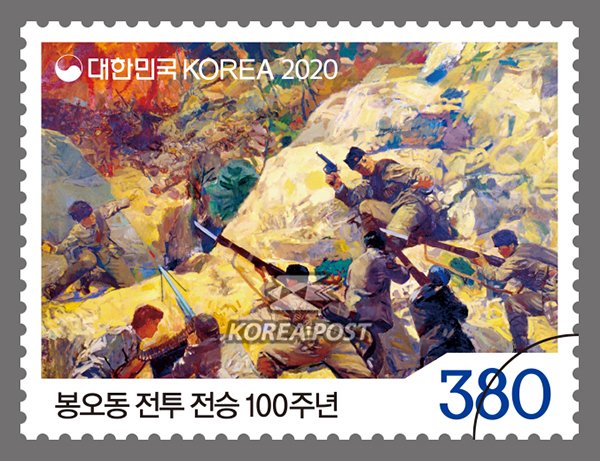
Stamp commemorating the Battle of Bongo-dong in 1920…
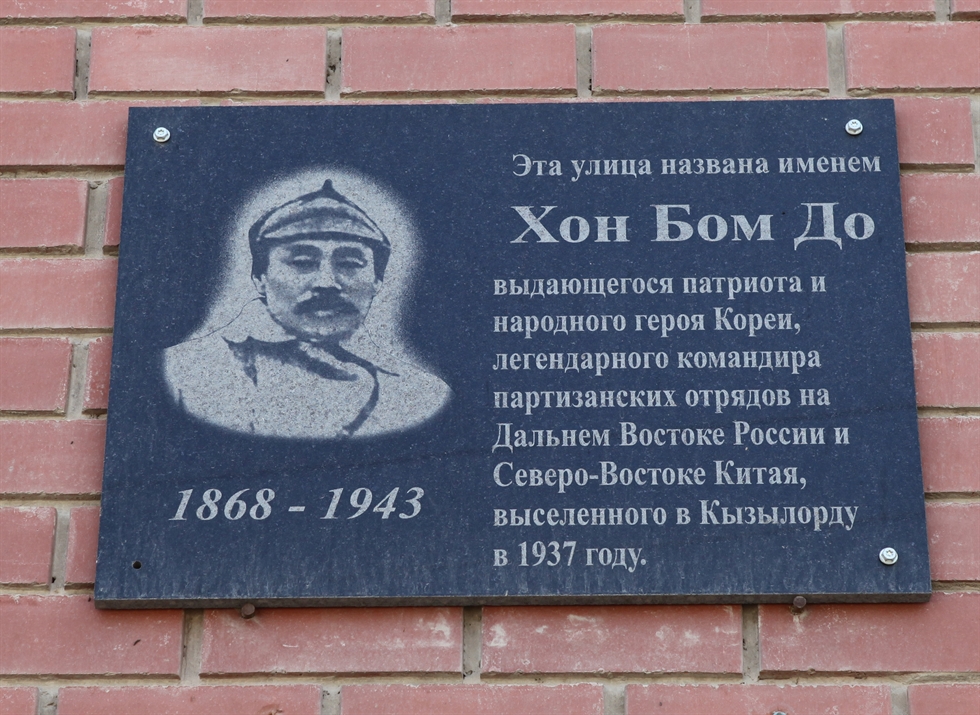
Marker in Russia about our hero, Hong Beom-do….

Near the front gate of Daejeon National Cemetery…
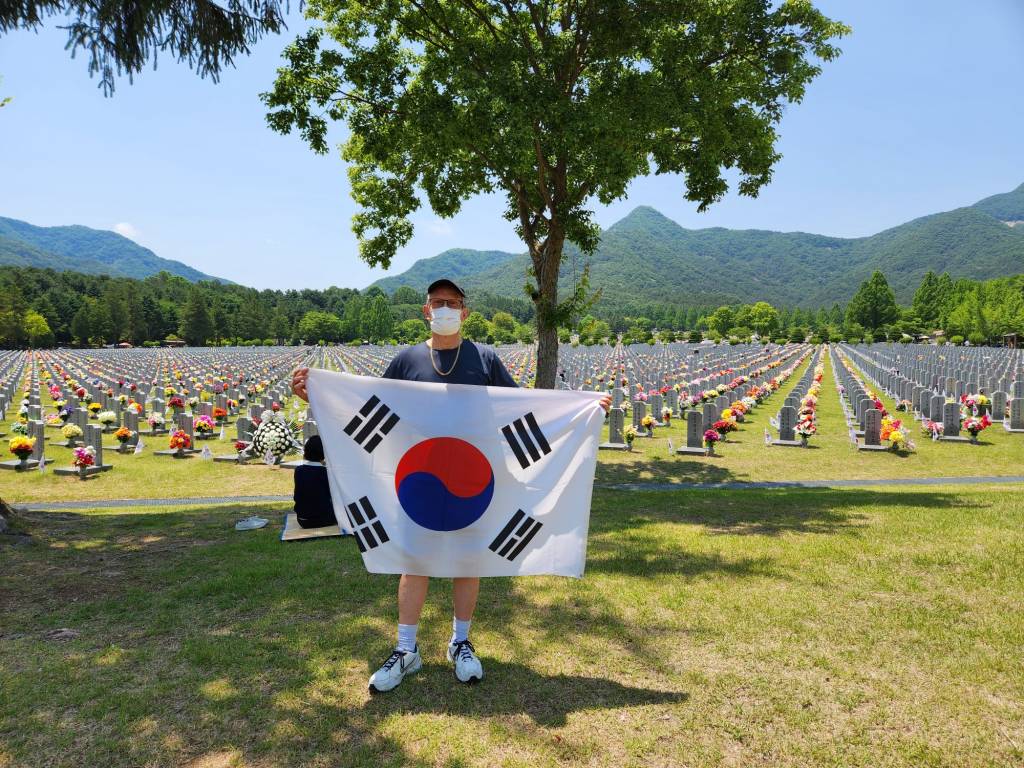
Displaying the Taekgukki at Daejeon National Cemetery, June 6, 2023….
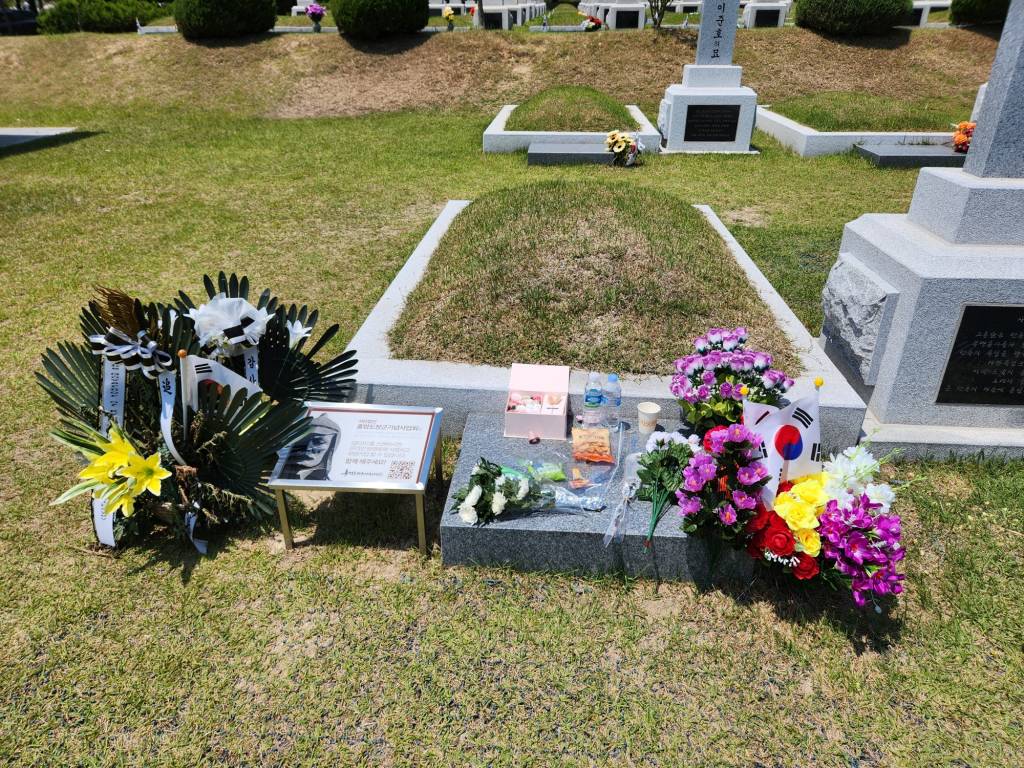
The grave of Hong Beom-do…
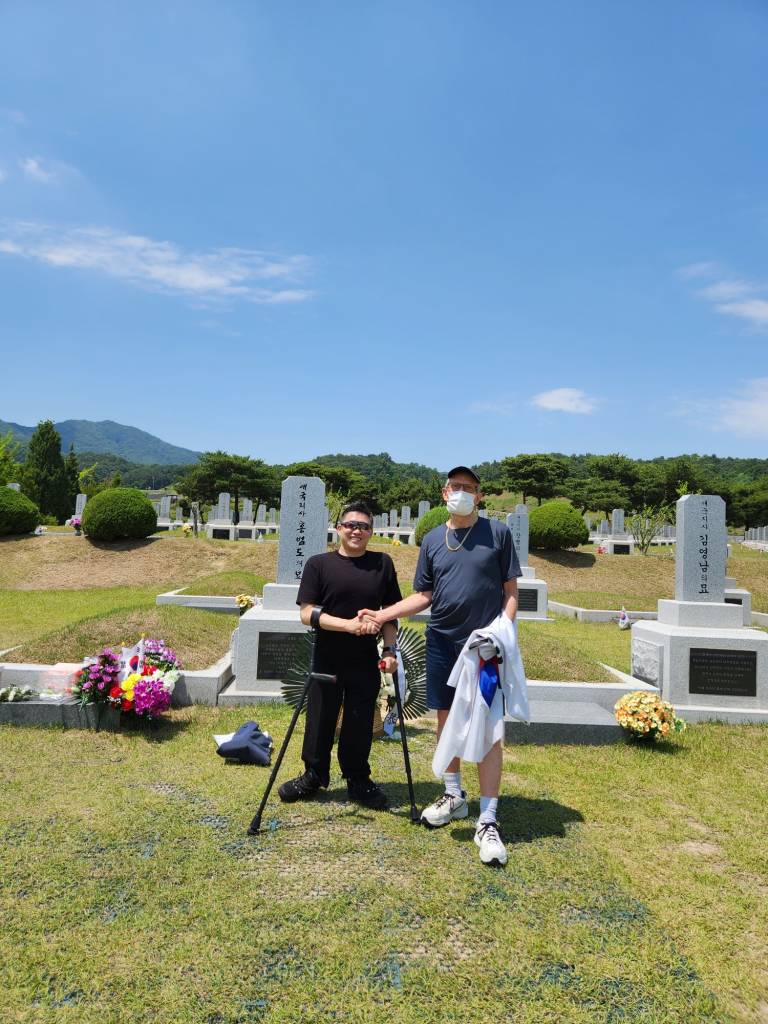
With Simon…
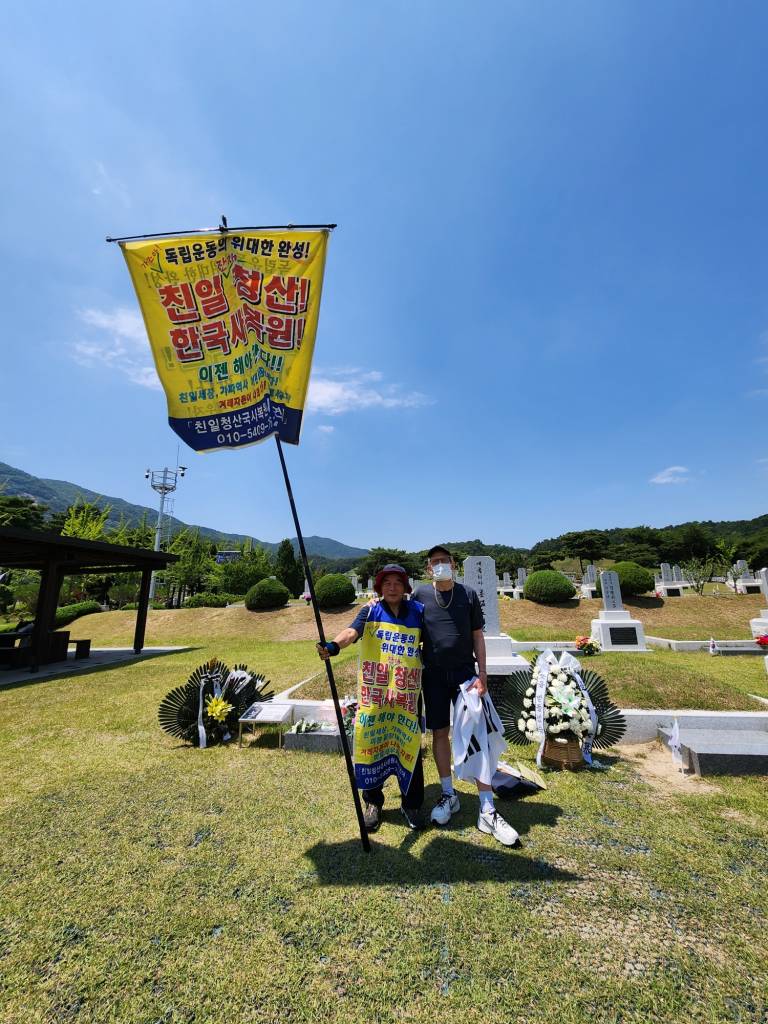
With Japan-hater Lee Jeon-oh…
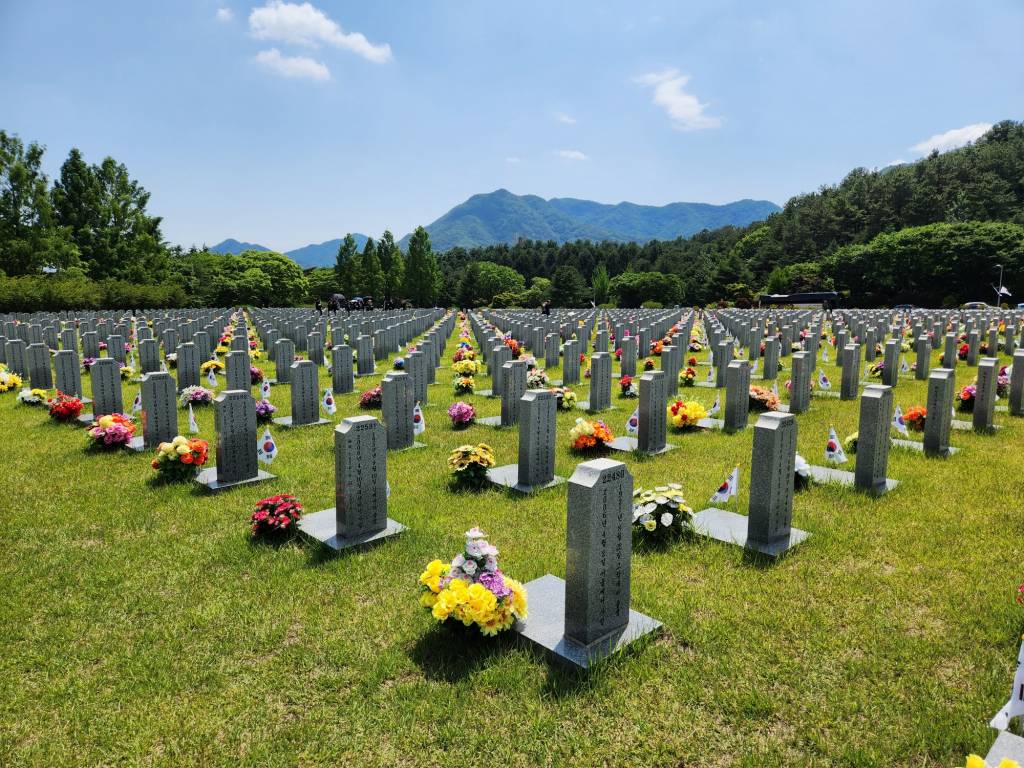
Daejeon National Cemetery…


Add Comment